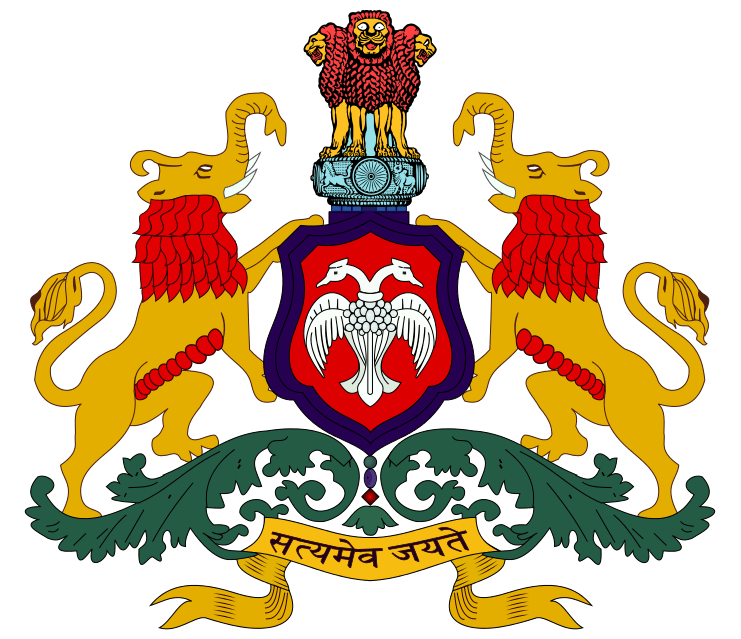Vokkaliga
Vokkaliga is a Hindu farming community with 54 sub-divisions in Karnataka. They have notable demographic, political, and economic dominance in the southern parts of the Indian state of Karnataka.[1][2] They are designated as an Other Backward Class in India's reservation system.[3]
Etymology
Vokkaliga is a Kannada-language word found in some of the earliest available literary works of the language, such as the Kavirajamarga, Pampa Bharata, and Mangaraja's Nighantu. It has been used as an appellation for the cultivator community since time immemorial.[4] Generally, the term has come to mean an agriculturist though various etymological derivations are available, including:
.jpg)
- The word okka or okkalu is a Kannada word for a family or a clan[5] and an okkaliga is a person belonging to such a family.[4] This is an allusion to the totemistic exogamous clans which together form an endogamous sub group, of which there are many amongst the Vokkaligas. These clans are called Bali, Bedagu, Kutumba, Gotra or simply Okkalu all of which mean family. They are named after their progenitor, primary occupation or in most cases after various birds, animals or objects.[6]
- Okkalutana in Kannada means agriculture[5]
- Alternate etymologies include okku, which means threshing[5]
The Kannada linguist Shamba Joshi and others propose a derivation from the Sanskrit - gau (cow) and govala (keeper of Gau/Cow)(Govala->Goula->Gowda).[4][7] Moreover, though the Vokkaligas did practise animal husbandry, Govalas (whence Golla) or the Yadavas/Kurubas form a separate caste group and they were traditionally herdsmen.[8]
Subgroups
The Vokkaliga community has several sub-groups within its fold. Exogamy at the family/clan level is strictly controlled by using the idiom of Mane Devaru (the patron god of the given exogamic clan) which dictates that the followers of same Mane Devaru are siblings and marriage is thus forbidden, allowing marital alliances only with another clan and not within.[9]
Gangadikara Vokkaliga
The Gangadikara Gowdas, also known as the Gangatkar, claim to be descendants of the erstwhile Ganga royalty.[4][10] With various theories on the origins of the Gangas, this is hard to prove but some scholars do opine that the Gangas were local chieftains who ascertained their power and rose to dominance during the political unrest caused in South India after the invasion of Samudragupta I. It is however, a fact that the administrative setup of Gangas vested power, at various levels of administration and apart from administrative duties the Gauda was expected to raise militia when called for.[11] The Gangadikaras and the Kongu Vellalars are said to share a common origin and they regard themselves Ganga Kshatriyas. In fact, the word Kongu is the Tamil equivalent for Ganga. There is a significant number of Kongu Vellala Gounders in Kollegala and T. Narsipur of southern Karnataka.[8]
The Gangadikara Vokkaligas have as many as 40 exogamous clans called Bedagu.[9][12]
Morasu Vokkaliga
The ancestors of Kempe Gowda I of the Yelahanka Nadaprabhus (the founder of Bangalore city and himself a Morasu Vokkaliga) are recorded to have migrated to these districts from Alur of Kanchi around the 15th century under Rana Bhaire Gowda, who built the fort at Devanahalli.[13]
According to Burton Stein, the region of modern-day Bangalore and Tumkur districts was known as Morasu Nadu, dominated by the Morasu Vokkaligas.[14] In fact Hosur which borders Bangalore claims to have been called Murasu Nadu during the Sangam Age[15] and has a significant population of Morasu Vokkaligas.
The four main sub-divisions being the Musuku, Hosadevru (Beralu), Palyadasime and Morasu proper which is again divided into three lines called Salu viz. Kanu salu, Nerlegattada salu, Kutera salu. The Musuku sect is so-called because the bride wears a veil or 'Musuku' during the wedding ceremony.[8]
Namadhari Vokkaligas
The Namadhari Vokkaliga group is the first largest Vokkaliga sub-group.[4]
Halakki Vokkaliga
Halakki Vokkaligas are an indigenous tribe in of Uttar Kannada district. Taking cognisance of the tribe’s demands to be recognised as a Scheduled Tribe a study was commissioned by the social welfare department in 2010 and a report was submitted.[16]
See also
References
- Robert, Bruce L. (1982). Agrarian organization and resource distribution in South India: Bellary District 1800-1979. University of Wisconsin--Madison. p. 88.
- "Born to be a force to reckon with". DNA India. 26 April 2010. Retrieved 14 March 2019.
- "PDF - National OBC list for Karnataka" (PDF).
- Dr. Ambalike Hiriyanna (1999). Malenadina Vaishnava Okkaligara Samskruti. Kannada Pustaka Pradhikara, Government of Karnataka.
- Kannada Nighantu. Kannada Sahitya Parishat, Bangalore. 1970.
- Ferreira, John Vincent (1965). Totemism in India. Oxford University Press.
- Dr. Ganapati Gowda (2011). Grama Okkaligara Samsrutika Ananyate Mattu Samakaleena Sandarbhagalu. Kannad University, Hampi.
- Dr. Suryanath. V. Kamath (1988). Karnataka State Gazetteer. Government Press, Bangalore.
- Dr. Bhavani Banerjee (1966). Marriage and Kinship of the Gangadikara Vokkaligas of Mysore. Deccan College Postgraduate and Research Institute, Poona.
- E.Stanley (1962). Economic Development and Social Change in South India. University of Manchester Press, Manchester.
- B.Sheik Ali (1976). History of the Western Gangas. University Of Mysore.
- "Archived copy" (PDF). Archived from the original (PDF) on 3 March 2012. Retrieved 27 December 2011.CS1 maint: archived copy as title (link)
- Phalaksha (1999). Introduction to Karnataka History. Shashi Prakashana, Tumkur.
- Burton Stein (1987). Vijayanagara. Cambridge University Press, Cambridge and New York. ISBN 9780521266932.
- "Krishnagiri District Website". Krishnagiri.tn.nic.in. 9 February 2004. Retrieved 23 December 2015.
- "Halakki Vokkaligas await inclusion in Scheduled Tribes' list - Times of India". The Times of India. Retrieved 16 March 2019.
